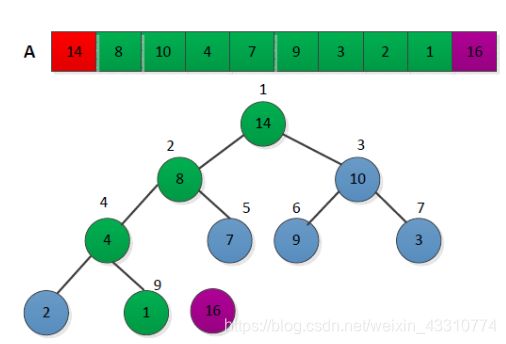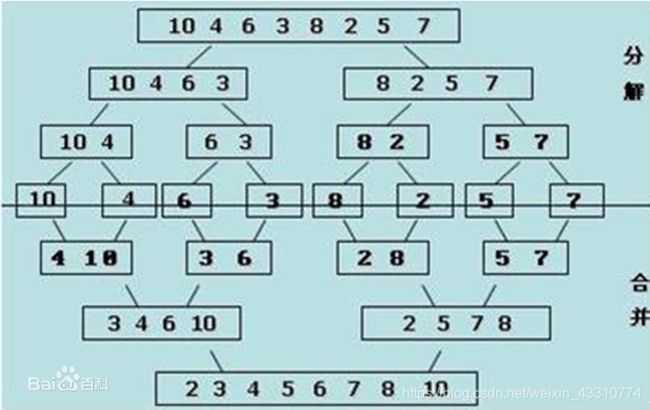实验八 内部排序
实验八 内部排序
1.(必做题)在完善“12.11.4 参考源程序”的基础上,进行典型内部排序算法的比较。
(1) 随机产生整数样本,进行8种排序,并比较各种排序算法的执行时间,如执行时间均为0,可考虑增大样本,如加大至5000或10000。
(2) 设计方案,修改“12.11.4 参考源程序”,对8种排序算法的数据元素比较次数和移动次数进行比较。
(3) 修改“12.11.4 参考源程序”,输出8种排序算法每一趟排序的输出结果。
学习一下
第一篇1
第二篇2
抄来的参考代码如下:原链接

堆排序
堆的概念
堆:本质是一种数组对象。特别重要的一点性质:任意的叶子节点小于(或大于)它所有的父节点。对此,又分为大顶堆和小顶堆,大顶堆要求节点的元素都要大于其孩子,小顶堆要求节点元素都小于其左右孩子,两者对左右孩子的大小关系不做任何要求。
利用堆排序,就是基于大顶堆或者小顶堆的一种排序方法。下面,我们通过大顶堆来实现。
基本思想:
堆排序可以按照以下步骤来完成:
1.首先将序列构建称为大顶堆;
(这样满足了大顶堆那条性质:位于根节点的元素一定是当前序列的最大值)

2.构建大顶堆
3.取出当前大顶堆的根节点,将其与序列末尾元素进行交换;
(此时:序列末尾的元素为已排序的最大值;由于交换了元素,当前位于根节点的堆并不一定满足大顶堆的性质)
对交换后的n-1个序列元素进行调整,使其满足大顶堆的性质;

重复2.3步骤,直至堆中只有1个元素为止
代码实现:
#-------------------------堆排序--------------------------------
#**********获取左右叶子节点**********
def LEFT(i):
return 2*i + 1
def RIGHT(i):
return 2*i + 2
#********** 调整大顶堆 **********
#L:待调整序列 length: 序列长度 i:需要调整的结点
def adjust_max_heap(L,length,i):
#定义一个int值保存当前序列最大值的下标
largest = i
#执行循环操作:两个任务:1 寻找最大值的下标;2.最大值与父节点交换
while (1):
#获得序列左右叶子节点的下标
left,right = LEFT(i),RIGHT(i)
#当左叶子节点的下标小于序列长度 并且 左叶子节点的值大于父节点时,将左叶子节点的下标赋值给largest
if (left < length) and (L[left] > L[i]):
largest = left
print('左叶子节点')
else:
largest = i
#当右叶子节点的下标小于序列长度 并且 右叶子节点的值大于父节点时,将右叶子节点的下标值赋值给largest
if (right < length) and (L[right] > L[largest]):
largest = right
print('右叶子节点')
#如果largest不等于i 说明当前的父节点不是最大值,需要交换值
if (largest != i):
temp = L[i]
L[i] = L[largest]
L[largest] = temp
i = largest
print(largest)
continue
else:
break
#********** 建立大顶堆 **********
def build_max_heap(L):
length = len(L)
for x in range((int)((length-1)/2),-1,-1):
adjust_max_heap(L,length,x)
#********** 堆排序 **********
def heap_sort(L):
#先建立大顶堆,保证最大值位于根节点;并且父节点的值大于叶子结点
build_max_heap(L)
#i:当前堆中序列的长度.初始化为序列的长度
i = len(L)
#执行循环:1. 每次取出堆顶元素置于序列的最后(len-1,len-2,len-3...)
2. 调整堆,使其继续满足大顶堆的性质,注意实时修改堆中序列的长度
while (i > 0):
temp = L[i-1]
L[i-1] = L[0]
L[0] = temp
#堆中序列长度减1
i = i-1
#调整大顶堆
adjust_max_heap(L,i,0)
归并排序
算法思想:

归并排序是建立在归并操作上的一种有效的排序算法,该算法是采用分治法的一个典型的应用。它的基本操作是:将已有的子序列合并,达到完全有序的序列;即先使每个子序列有序,再使子序列段间有序。
归并排序其实要做两件事:
分解----将序列每次折半拆分
合并----将划分后的序列段两两排序合并
因此,归并排序实际上就是两个操作,拆分+合并
如何合并?
L[first…mid]为第一段,L[mid+1…last]为第二段,并且两端已经有序,现在我们要将两端合成达到L[first…last]并且也有序。
首先依次从第一段与第二段中取出元素比较,将较小的元素赋值给temp[]
重复执行上一步,当某一段赋值结束,则将另一段剩下的元素赋值给temp[]
此时将temp[]中的元素复制给L[],则得到的L[first…last]有序
如何分解?
在这里,我们采用递归的方法,首先将待排序列分成A,B两组;然后重复对A、B序列
分组;直到分组后组内只有一个元素,此时我们认为组内所有元素有序,则分组结束。
代码实现
# 归并排序
#这是合并的函数
# 将序列L[first...mid]与序列L[mid+1...last]进行合并
def mergearray(L,first,mid,last,temp):
#对i,j,k分别进行赋值
i,j,k = first,mid+1,0
#当左右两边都有数时进行比较,取较小的数
while (i <= mid) and (j <= last):
if L[i] <= L[j]:
temp[k] = L[i]
i = i+1
k = k+1
else:
temp[k] = L[j]
j = j+1
k = k+1
#如果左边序列还有数
while (i <= mid):
temp[k] = L[i]
i = i+1
k = k+1
#如果右边序列还有数
while (j <= last):
temp[k] = L[j]
j = j+1
k = k+1
#将temp当中该段有序元素赋值给L待排序列使之部分有序
for x in range(0,k):
L[first+x] = temp[x]
# 这是分组的函数
def merge_sort(L,first,last,temp):
if first < last:
mid = (int)((first + last) / 2)
#使左边序列有序
merge_sort(L,first,mid,temp)
#使右边序列有序
merge_sort(L,mid+1,last,temp)
#将两个有序序列合并
mergearray(L,first,mid,last,temp)
# 归并排序的函数
def merge_sort_array(L):
#声明一个长度为len(L)的空列表
temp = len(L)*[None]
#调用归并排序
merge_sort(L,0,len(L)-1,temp)
用了很多功夫抄了别人的代码过来,一定要好好学习,天天向上!!!
#include